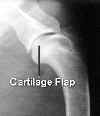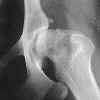
By T. J. Dunn, Jr., DVM
Almost every six months a new medication becomes available to veterinarians that helps keep arthritic dogs more mobile and pain free. Any products listed here are only a sample of various medications or supplements that can have a positive impact on dogs (and cats) that have arthritis. Be sure to check with our veterinarian for updated information on the safety and effectiveness of any medication before it is used on your pet to help improve the pet's quality of life.
Arthritis in dogs is a common and difficult disorder to manage. For instance, during a routine exam of a six-year-old German Shepard prior to vaccinations, the client remarked that the dog seemed to be a little slower moving lately and was more careful about lying down and getting up. There were no obvious indicators of pain or limping, just a "careful" attitude on the dog’s part when changing positions.
In the end my evaluation of the dog’s limbs showed a reduced range of motion in the hips, the stifles (knees) were normal, and there was no evidence of back pain when I pushed and probed along the spine.
I considered early arthritis in the hips as a possible explanation for the subtle signs the owner had observed. We decided to sedate the dog and take some X-rays. What a surprise we had! This dog, only displaying the subtlest of signs of discomfort, had advanced degeneration of both hip joints (called coxofemoral osteoarthritis) and early bony changes of the lower spine.
In contrast to this case other patients that radiographically show only minimal signs of arthritic degeneration in the joints often will display definite signs of discomfort, lameness and restricted mobility. The bottom line is this: Arthritis, joint inflammation and degeneration -- they are all is personal. Because there are so many variables associated with joint degenerative changes on both a microscopic and macroscopic level, each case must be evaluated individually; every dog responds uniquely to discomfort and pain.
Arthritis is a general term for abnormal changes in a joint. It can arise from joint tissue destruction subsequent to an infection, from congenital defects affecting structural architecture, and from stress and trauma to joint surfaces and supporting structures. Occasionally, disorders of the immune system will lead to joint tissue inflammation and degeneration.
In commonly seen cases of hip dysplasia, arthritis is partly due to abnormal conformation and misaligned stress points of the coxofemoral joint. The cartilage is adversely impacted and wears away faster than it can regenerate. The bony layer beneath the cushioning cartilage can be exposed and becomes inflamed; the joint capsule surrounding the joint members becomes thickened, less elastic and highly sensitive. Blood vessels to and from the area of the joint dilate and the joint becomes swollen and inflamed. Elastic tissues of the joint stiffen, calcium deposits can build up and nerve endings send pain signals to the brain. Motion becomes more and more restricted due to the joint degeneration, and the discomfort and pain prompts the patient to reduce the use of the joint.
Unfortunately, the reduced use further compounds the problems associated with arthritis because the patient then gains weight and continued disuse further limits joint mobility.

 The hip on the right is partially dislocated and early arthritis has begun to develop. Click http://www.petmd.com/sites/default/files/arth_2_HD.jpg" target="_blank">here to see a large view of a different patient with advanced hip arthritis.
A side view of a dog spinal column with spondylosis... fusion of vertebrae and overgrowth of abnormal bony tissue.
The hip on the right is partially dislocated and early arthritis has begun to develop. Click http://www.petmd.com/sites/default/files/arth_2_HD.jpg" target="_blank">here to see a large view of a different patient with advanced hip arthritis.
A side view of a dog spinal column with spondylosis... fusion of vertebrae and overgrowth of abnormal bony tissue.

 A loose flap of cartilage in the shoulder will lead eventually to arthritis of this joint. See article about this condition, called OCD.
Arthritis of a hip joint due to a flattened femoral head, short femoral neck and shallow hip socket. See more information about Hip Dysplasia in this article.
A loose flap of cartilage in the shoulder will lead eventually to arthritis of this joint. See article about this condition, called OCD.
Arthritis of a hip joint due to a flattened femoral head, short femoral neck and shallow hip socket. See more information about Hip Dysplasia in this article.
As a survival tactic animals have evolved into stoic creatures that rarely display outward signs of pain or discomfort. Fortunately for our domestic dogs, no less stoic than their wild ancestors, veterinarians today are much more "tuned in" to pain management than in the past. They look for subtle signs in patients in order to discover early stages of arthritis since outright limping or vocalizing from pain may be the end stage of long-term joint degeneration.
Likewise, you need to be aware of these subtle changes in your dog’s behavior. Typically what will be noticed first are an increased weight gain, sleeping more, less interest in playing, and a change in attitude or alertness. If your dog becomes less excited to greet you when you come home or vacillates about jumping up on the couch or becomes overly cautious when climbing stairs, be aware that these may be the first indicators of joint discomfort from arthritis.
It is important to first note that as with any medication, and especially with non-steroidal anti-inflammatory medications such as many pain relieving "arthritis medications", there can be occasional adverse reactions for individual patients.
There are many anti-inflammatory medications that are prescribed for dogs. You and your veterinarian need to discuss the pros and cons of any medication your dog (or cat) is taking, especially those being taken on a continuing basis.
Immediately discontinue use of any medication, and contact your veterinarian, as soon as a suspected adverse reaction occurs. Reactions can be variable, subtle, severe, or unusual; individual attention to each medication's potential adverse effects should be discussed with your veterinarian.
Fortunately there are safe and effective medications available for dogs that are suffering from the debilitating effects of arthritis. One of the most prescribed medications is a product called Carprofen. As with any medication, however, safety is an issue.
I asked J. Michael McFarland, DVM, DABVP, Director of the Sedation and Pain Management Team at Pfizer Animal Health's Companion Animal Division, about the safety of Carprofen, especially since many of the dogs needing arthritis discomfort relief are older animals. McFarlane makes a good point when he says, " Whenever any medication is used for long term therapy for ongoing conditions, such as diabetes, epilepsy, thyroid dysfunction or kidney disease, the veterinarian will need to do some ongoing testing. Deramaxx is one comonly used anti inflammatory medication used in dogstesting. That’s why blood chemistry parameters are routinely checked whenever long-term drug therapy is administered in the treatment of diseases. Periodic blood tests should be evaluated when any NSAIDS are used in the treatment of osteoarthritic pain.” NSAIDS (non-steroidal anti-inflammatory drug) is a class of anti-inflammatory medication, such as aspirin, that do not contain cortisone-like chemicals.
Meloxicam is a liquid NSAID that has been well accepted for arthritis management in dogs and is now available in the U.S. by prescription only from your veterinarian. Other anti-arthritis medications are being studied and released for use in animals, much to the joy of dogs and their owners!
Keeping excess body weight to a minimum is a very important aspect of managing arthritis in dogs. Often, simply reducing the dog’s weight to a reasonable level will effect noticeable changes in the dog’s activity and mobility. Exercise is important to entice the dog to maintain and improve joint movement and flexibility. Soft, cushioned sleeping surfaces that keep the dog comfortable and warm may aid in lessening arthritic discomfort. A hardwood floor of a living room or doghouse will not serve the dog well in alleviating joint stiffness. Massage therapy should be considered, too.
In the past few years a number of products called nutraceuticals have also had remarkable success in assisting dogs with various disorders, including arthritis. Defined as a food or naturally occurring food supplement thought to have a beneficial effect on health, nutraceuticals are not considered medications and can be obtained without a prescription. Among the most popular are chondroprotectives … substances that when eaten provide nutrients that are required for repair and maintenance of joint tissue.
According to veterinarian Stacy Martin of Fort Dodge Animal Health, "Nutraceuticals with glucosamine and chondroitin sulfate have been proven to aid dogs with osteoarthritis. With so many choices of these products available it is very important to purchase a product that has been made by a manufacturer who maintains high manufacturing standards. All over-the-counter products may not have the same quantity or have the same quality of products listed on their ingredients."
Martin added, "Oral nutraceuticals such as chondroprotectives repair and reduce cartilage breakdown in a joint."
One of the most effective treatment approaches can be to use NSAIDs and chondroprotectives together. There are many ways to help battle the pain and progression of osteoarthritis. Based on the type of osteoarthritis and the individual dog, management may require only one or possibly many approaches. Some approaches include exercise programs, weight control, nutraceuticals and NSAID use.
Often, the nutraceutical is not enough to ease your pet's pain. An NSAID is often used in conjunction or alone in the management of pain and inflammation associated with osteoarthritis. As well, there is evidence that omega fatty acids in the diet can help alleviate the inflammation and discomfort of arthritis.
One last word of caution. Some medications that humans commonly take to subdue arthritic discomfort are totally inappropriate for use in dogs. Acetaminophen, for example, has been associated with liver damage in dogs. And Ibuprophen has been reported to cause gastro-intestinal bleeding.
Martin provides good advice when she says, "Your veterinarian will help you decide which course of action is best for your pet. It is very important not to try treating your pet with any type of product, nutraceutical or NSAID, without consulting your veterinarian. It is also important to use FDA approved products for animals rather than a product made for humans. Together with your veterinarian, you can devise a program for your dog to let him have a happier, more active life."
Image: Francis Mariani / via Flickr
 Enzyme Replacement Therapy for EPI
Exocrine pancreatic insufficiency (EPI) is
Enzyme Replacement Therapy for EPI
Exocrine pancreatic insufficiency (EPI) is
 Itch-And-Scratch-Bite-And-Lick!
Cat and Dog Skin Problems
By T. J. Dunn, Jr., DVM
Itch-And-Scratch-Bite-And-Lick!
Cat and Dog Skin Problems
By T. J. Dunn, Jr., DVM
 Anal Sacs Problems in Dogs (and Cats)
By T. J. Dunn, Jr., DVM
Few topics raise dog owner
Anal Sacs Problems in Dogs (and Cats)
By T. J. Dunn, Jr., DVM
Few topics raise dog owner
 Reducing Pet Fear in the Veterinary Setting: One Veterinarian’s Experience
This article is courtesy of The Hannah Society.
&n
Reducing Pet Fear in the Veterinary Setting: One Veterinarian’s Experience
This article is courtesy of The Hannah Society.
&n
 New Ways To Save More Funds While Shopping Car Insurance
Some elements that induce the expense of your insurance c
New Ways To Save More Funds While Shopping Car Insurance
Some elements that induce the expense of your insurance c
Copyright © 2005-2016 Pet Information All Rights Reserved
Contact us: www162date@outlook.com